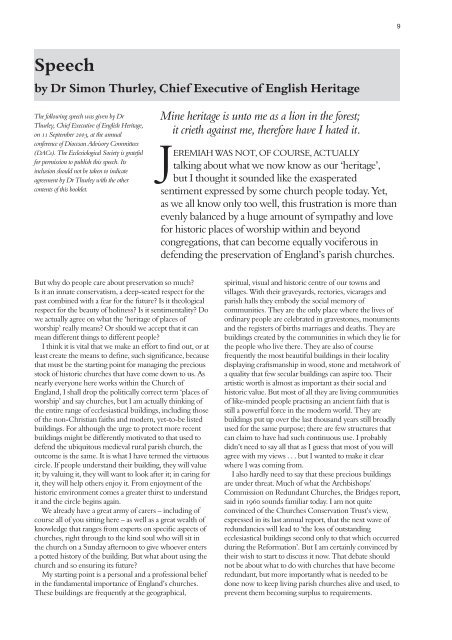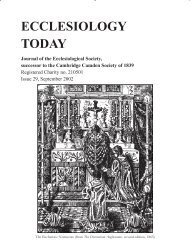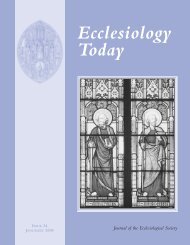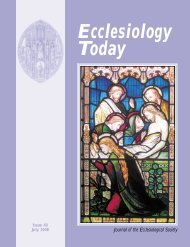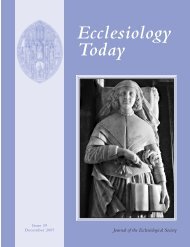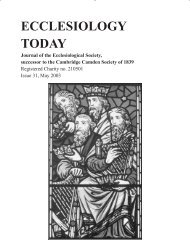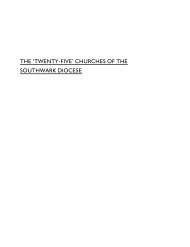PARISH CHURCHES? how do we keep our - Ecclesiological Society
PARISH CHURCHES? how do we keep our - Ecclesiological Society
PARISH CHURCHES? how do we keep our - Ecclesiological Society
Create successful ePaper yourself
Turn your PDF publications into a flip-book with our unique Google optimized e-Paper software.
9<br />
Speech<br />
by Dr Simon Thurley, Chief Executive of English Heritage<br />
The following speech was given by Dr<br />
Thurley, Chief Executive of English Heritage,<br />
on 11 September 2003, at the annual<br />
conference of Diocesan Advisory Committees<br />
(DACs). The <strong>Ecclesiological</strong> <strong>Society</strong> is grateful<br />
for permission to publish this speech. Its<br />
inclusion should not be taken to indicate<br />
agreement by Dr Thurley with the other<br />
contents of this booklet.<br />
Mine heritage is unto me as a lion in the forest;<br />
it crieth against me, therefore have I hated it.<br />
J<br />
EREMIAH WAS NOT, OF COURSE, ACTUALLY<br />
talking about what <strong>we</strong> now know as <strong>our</strong> ‘heritage’,<br />
but I thought it sounded like the exasperated<br />
sentiment expressed by some church people today. Yet,<br />
as <strong>we</strong> all know only too <strong>we</strong>ll, this frustration is more than<br />
evenly balanced by a huge amount of sympathy and love<br />
for historic places of worship within and beyond<br />
congregations, that can become equally vociferous in<br />
defending the preservation of England’s parish churches.<br />
But why <strong>do</strong> people care about preservation so much?<br />
Is it an innate conservatism, a deep-seated respect for the<br />
past combined with a fear for the future? Is it theological<br />
respect for the beauty of holiness? Is it sentimentality? Do<br />
<strong>we</strong> actually agree on what the ‘heritage of places of<br />
worship’ really means? Or should <strong>we</strong> accept that it can<br />
mean different things to different people?<br />
I think it is vital that <strong>we</strong> make an effort to #nd out, or at<br />
least create the means to de#ne, such signi#cance, because<br />
that must be the starting point for managing the precious<br />
stock of historic churches that have come <strong>do</strong>wn to us. As<br />
nearly everyone here works within the Church of<br />
England, I shall drop the politically correct term ‘places of<br />
worship’ and say churches, but I am actually thinking of<br />
the entire range of ecclesiastical buildings, including those<br />
of the non-Christian faiths and modern, yet-to-be listed<br />
buildings. For although the urge to protect more recent<br />
buildings might be differently motivated to that used to<br />
defend the ubiquitous medieval rural parish church, the<br />
outcome is the same. It is what I have termed the virtuous<br />
circle. If people understand their building, they will value<br />
it; by valuing it, they will want to look after it; in caring for<br />
it, they will help others enjoy it. From enjoyment of the<br />
historic environment comes a greater thirst to understand<br />
it and the circle begins again.<br />
We already have a great army of carers – including of<br />
c<strong>our</strong>se all of you sitting here – as <strong>we</strong>ll as a great <strong>we</strong>alth of<br />
knowledge that ranges from experts on speci#c aspects of<br />
churches, right through to the kind soul who will sit in<br />
the church on a Sunday afternoon to give whoever enters<br />
a potted history of the building. But what about using the<br />
church and so ensuring its future?<br />
My starting point is a personal and a professional belief<br />
in the fundamental importance of England’s churches.<br />
These buildings are frequently at the geographical,<br />
spiritual, visual and historic centre of <strong>our</strong> towns and<br />
villages. With their graveyards, rectories, vicarages and<br />
parish halls they embody the social memory of<br />
communities. They are the only place where the lives of<br />
ordinary people are celebrated in gravestones, monuments<br />
and the registers of births marriages and deaths. They are<br />
buildings created by the communities in which they lie for<br />
the people who live there. They are also of c<strong>our</strong>se<br />
frequently the most beautiful buildings in their locality<br />
displaying craftsmanship in wood, stone and metalwork of<br />
a quality that few secular buildings can aspire too. Their<br />
artistic worth is almost as important as their social and<br />
historic value. But most of all they are living communities<br />
of like-minded people practising an ancient faith that is<br />
still a po<strong>we</strong>rful force in the modern world. They are<br />
buildings put up over the last thousand years still broadly<br />
used for the same purpose; there are few structures that<br />
can claim to have had such continuous use. I probably<br />
didn’t need to say all that as I guess that most of you will<br />
agree with my views...butIwanted to make it clear<br />
where I was coming from.<br />
I also hardly need to say that these precious buildings<br />
are under threat. Much of what the Archbishops’<br />
Commission on Redundant Churches, the Bridges report,<br />
said in 1960 sounds familiar today. I am not quite<br />
convinced of the Churches Conservation Trust’s view,<br />
expressed in its last annual report, that the next wave of<br />
redundancies will lead to ‘the loss of outstanding<br />
ecclesiastical buildings second only to that which occurred<br />
during the Reformation’. But I am certainly convinced by<br />
their wish to start to discuss it now. That debate should<br />
not be about what to <strong>do</strong> with churches that have become<br />
redundant, but more importantly what is needed to be<br />
<strong>do</strong>ne now to <strong>keep</strong> living parish churches alive and used, to<br />
prevent them becoming surplus to requirements.


